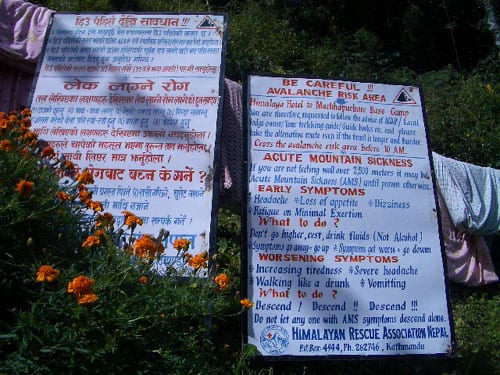Acute mountain sickness is more than one syndrome
I know what you’re thinking, but I’m not just talking about HAPE and HACE here. But when acute mountain sickness affects up to half of those who ascend beyond 4500m, it’s something we really don’t know as much about as we would like. Currently the definition includes one or more of the following: headache, sleep disturbance, fatigue, and dizziness. This is all scored using the Lake Louise Scoring System. But like with GCS, you can have the same score with a completely different clinical picture.
One major requirement for acute mountain sickness is headache though. It probably is due to vasogenic cerebral edema causing ICP elevation, as you can measure increases in optic nerve sheath diameter with increases in score.
Sleep disturbance doesn’t seem to be mediated by cerebral edema though. It appears hypoxia mediated, causing an increase in respiratory rate that then causes hypocapnia followed by a compensatory reduction in respiratory drive/rate. This periodic breathing interrupts deep sleep like obstructive sleep apnea does.
Back to the study though. They used 103 participants in the Bolivian Andes, and 189 participants climbing Mt. Kilimanjaro. They were given a survey that had 7 questions about their symptoms. After measuring the VAS by hand, it was plugged into a network analysis tool to find patterns in the data.
What they found were two different clinical syndromes that resulted in three groups of patients. The largest group was those with poor sleep and fatigue but no headache symptoms. The second smaller group had headaches, poor sleep, and fatigue. The smallest group had headache but no sleep disturbance. An interesting tidbit from the study was that there wasn’t a statistical difference between the groups in Bolivia who were randomized to placebo, antioxidants, or Viagra. None of those subjects took acetazolamide or NSAIDs.
Of note, 25 of the subjects in Bolivia were evacuated for severe AMS, but there was only one case of HAPE and no cases of HACE in the entire study. So while they all had symptoms, they perhaps weren’t as bad off as they could have been.
So what does this mean? First, almost everyone at altitude has some degree of fatigue. I like to think it is likely because they weren’t dropped off by a helicopter but instead had to climb to get there, but we have to take the data at face value. However, sleep problems and headaches were distinct from each other with only some overlap. So maybe we should either change the condition we consider AMS, or make different scoring systems for the different pathophysiologic issues. Otherwise you are possibly neglecting one disease process while treating the other. Just like with GCS, you don’t treat everyone with the same score exactly the same, but with the LLS, you might.
Hall DP et al. Network analysis reveals distinct clinical syndromes underlying acute mountain sickness. PLoS One. 2014 Jan 22;9(1):e81229. [PMC3898916]
Further Reading
- Hensley J. Climbing? Having trouble sleeping? EBM Gone Wild
- Hensley J. Deep breathing to prevent acute mountain sickness EBM Gone Wild
- Hensley J. A novel prevention for acute mountain sickness. EBM Gone Wild
- Hensley J. Predicting altitude sickness? EBM Gone Wild

EBM Gone Wild
Wilderness Medicine
Emergency physician with interests in wilderness and prehospital medicine. Medical Director of the Texas State Aquarium, Padre Island National Seashore, Robstown EMS, and Code 3 ER | EBM gone Wild | @EBMGoneWild |

